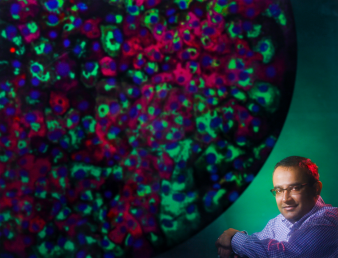Microfabricated Tissue Models Lab goes all-in on liver research with two new federal grants

By David Brazy, UIC
A Richard and Loan Hill Department of Bioengineering lab is hoping to break ground in liver testing research on two separate fronts by better re-creating real-life conditions in the lab.
Associate Professor Salman Khetani is the principal investigator on two grants worth more than $500,000 that his Microfabricated Tissue Models Lab received. The first grant, titled “3D Nanostructures For In Vitro Liver Testing” is from the National Science Foundation and includes $300,000 for UIC. The second grant, titled “High-throughput exploration of chemomechanical crosstalk in the maturation of iPSC-derived human hepatocytes” is from the National Institute of Environmental Health Sciences of the NIH and includes $204,512 for UIC.
The NSF grant is focused on creating ways to help human induced pluripotent stem cell (iPSC)-derived human liver cells mature so they can be effective drug-screening tools, according to Khetani.
The technology that allows scientists to develop iPSC-derived human cells has led to major breakthroughs by allowing the creation of different organ types, but those cells do not really function in the same ways as native cells in the human body do.
“What happens is if these iPSC derived liver cells are not highly functional, then using them for drug screening doesn’t make a lot of sense,” Khetani said. “You are indeed testing drugs on cells, but if those cells are not adequately functional, then they are not representative of what is actually going on in the body.”
Khetani partnered with Colorado State University Professor Matt Kipper’s group to build novel three-dimensional scaffolds that can more closely mimic those real-life conditions.
Kipper’s team uses donated livers and removes all the cells from the organ, which results in a powder that can be used to create nanofibers for the scaffolds. Khetani said this strategy removes the guesswork of trying to recreate the thousands of components in the matrixes in the body because they are using all the material from real human livers.
In addition to the 3D scaffolds, the engineers will also incorporate coating strategies to deliver growth factors in a physiological way to the main liver cells known as hepatocytes, as well as other cell types of the liver that support functions in the hepatocytes. The ultimate goal of all these experiments is to create a mature 3D liver cell model. This study would then focus on incorporating the mature cells into multi-well plates that researchers use for drug screening. But Khetani has his eyes on more ambitious goals as well.
“Let’s say we succeed and create a fairly mature cell… now, the sky is the limit,” Khetani said. “You can test and develop new drugs on it, you can develop and screen vaccines, you can use these cells for regenerative medicine. That’s what our eventual goal in all of our research is to get to surrogate human livers that can be customized for individual patients.”
The second grant focuses more on the fundamental development of the liver, instead of a targeted study to create a drug screening device. Khetani, along with bioengineering PhD student Chase Monckton, and Associate Professor Gregory Underhill and his team from the University of Illinois at Urbana Champaign will try to better understand the biophysical environmental parameters that mature iPSC derived liver cells further.
Khetani noted that most cells are cultured on plastic because it’s convenient and the go-to workhorse in the field, but this does not really match the mechanical environment in the body.
To get around this issue, Khetani’s team is partnering with Monckton and Underhill to create different polymers on glass slides that can be tuned to different stiffnesses, which can be matched to certain organs in the body. The researchers can also include different protein compositions in the polymers to see which combinations produce the most mature liver cells, something that can only be determined via high-throughput experimentation using tools developed by the Underhill laboratory.
The team will also be investigating the interaction between hepatocytes and liver endothelial cells, which play a critical role in developing the liver in an embryo. Khetani added they are hoping to discover how the biophysical environment of the liver and endothelial cells dictate the maturation and growth of the hepatocytes and vice versa.
“We want fundamental knowledge about what dictates cell behavior,” Khetani said. “The application will be a follow-up grant or collaborate with people where they can design scaffolds for transplantation that have certain stiffnesses or certain protein compositions.”
